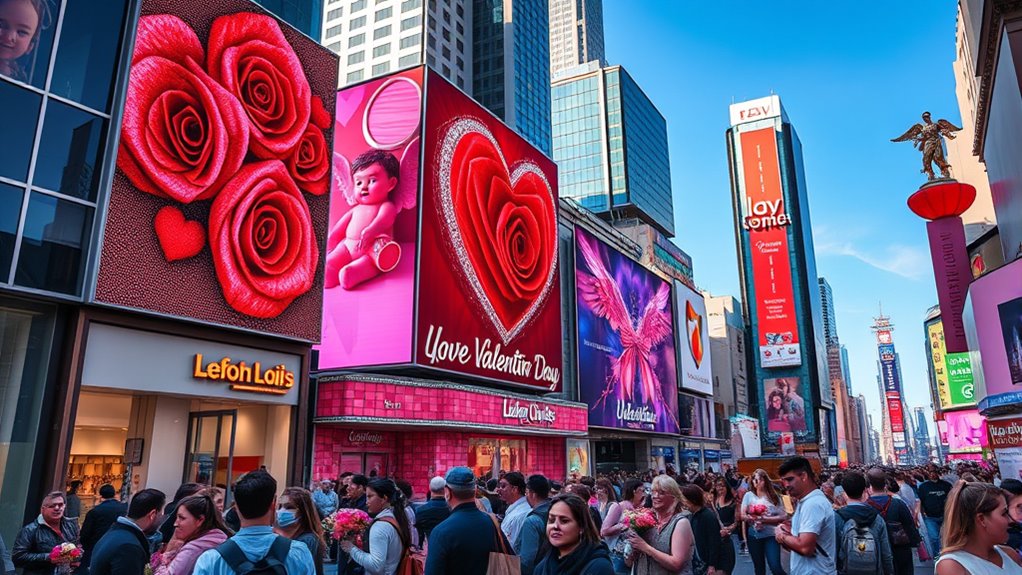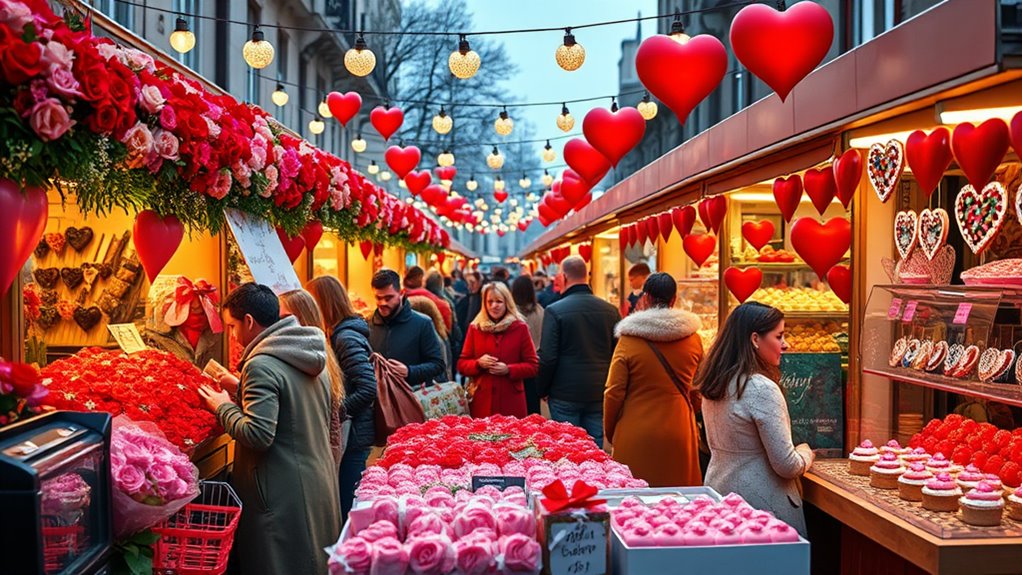Few realize that Valentine’s Day has grown into a multi-billion-dollar industry, surpassing many traditional holidays in economic impact. Behind the romantic gestures and heartfelt gifts lies a complex web of commerce that fuels countless businesses worldwide. From floral shops to luxury jewelers, this holiday’s influence extends far beyond love itself. Discover how a day dedicated to affection transformed into a powerful economic force that continues to shape markets and consumer habits.
Key Takeaways
- Valentine’s Day evolved from religious roots to a global celebration of love, boosting consumer spending worldwide.
- The holiday’s commercialization transformed simple gestures into multi-billion dollar markets for gifts, jewelry, and flowers.
- Emotional marketing through cards and symbols like hearts and roses drives impulse buying and personalized gift options.
- Industries such as confectionery, jewelry, and hospitality generate significant revenue during February due to Valentine’s Day.
- Digital marketing, influencer partnerships, and eco-friendly trends continue to expand the holiday’s economic impact responsibly.
The Origins of Valentine’s Day and Its Cultural Significance

Valentine’s Day traces its origins back to ancient Rome, where it was originally celebrated as a festival honoring Saint Valentine, a martyr known for secretly marrying couples despite Roman laws banning marriages. The historical origins of this day highlight its roots in compassion and defiance. Over time, it gained cultural significance as a day to honor love and affection, transcending its religious beginnings. In many societies, Valentine’s Day became a symbol of romantic devotion, celebrated with gift-giving and heartfelt gestures. Its cultural importance grew as it spread across different regions, evolving into a celebration of love that extends beyond romantic relationships to include friends and family. Today, this day’s rich history continues to influence how people express their feelings worldwide. Understanding zoning regulations can also be valuable for individuals considering how cultural events or festivities are planned and observed in different communities.
The Evolution From Romantic Tradition to Commercial Enterprise

You might notice how Valentine’s Day has shifted from simple romantic gestures to a major commercial event. Gift-giving has expanded from heartfelt notes to elaborate purchases, driven by marketing and media. This transformation shows how business interests now shape what the holiday represents. Additionally, the influence of consumer electronics and entertainment industries has further fueled the holiday’s commercial growth, appealing to diverse interests and boosting spending.
Romantic Roots to Commerce
Although the roots of Valentine’s Day celebrations trace back to ancient traditions honoring love and devotion, over time, the holiday has transformed from a purely romantic observance into a thriving commercial enterprise. Today, romantic symbolism like hearts, roses, and Cupid’s arrow are embedded in cultural traditions, shaping how businesses market products. What once emphasized personal connection now drives industries that capitalize on emotional appeal. Retailers leverage these symbols to promote everything from greeting cards to jewelry, turning love into a commodity. This shift reflects how cultural traditions have been adapted to serve economic interests, fueling a billion-dollar industry. The use of romantic decor and symbols has become a key element in marketing strategies, further entrenching Valentine’s Day as a major commercial event. You can see this evolution in the way Valentine’s Day is celebrated worldwide, blending genuine sentiment with strategic marketing to boost sales.
Gift-Giving Evolution
Over time, the tradition of gift-giving on Valentine’s Day has shifted from simple, heartfelt tokens to a highly commercialized practice driven by marketing strategies. Originally, gifts carried deep historical symbolism, like handmade cards or flowers symbolizing love and admiration. Today, cultural adaptations have expanded gift options globally, from chocolates in the West to jewelry in Asia. This evolution reflects changing societal values and commercial influences, transforming a romantic gesture into a mass-market event. The table below illustrates this transformation:
| Traditional Gifts | Modern Commercial Gifts |
|---|---|
| Handwritten notes | Pre-packaged chocolates |
| Simple flowers | Jewelry and gadgets |
| Personal tokens | Branded merchandise |
Additionally, the influence of large entertainment corporations and media marketing has played a significant role in popularizing these commercialized gift-giving trends.
Marketing and Media Influence
Have marketing campaigns and media coverage played a pivotal role in transforming Valentine’s Day from a heartfelt tradition into a commercial enterprise? Absolutely. Digital advertising now floods your feeds, showcasing romantic gifts, special deals, and themed promotions, making it impossible to ignore. Influencer partnerships amplify this effect, as popular personalities share their Valentine’s Day celebrations and product endorsements, shaping consumer preferences. Media coverage focuses on the latest trends, creating a sense of urgency and exclusivity around holiday shopping. This constant exposure shifts the focus from genuine emotion to consumption, encouraging you to buy more to celebrate love. Additionally, the power of marketing has been instrumental in transforming the holiday into a multi-billion dollar industry. Over time, marketing strategies have turned Valentine’s Day into a lucrative event, where media influence and digital advertising drive billions in sales annually.
The Role of Jewelry and Gift Retailers in the Valentine’s Economy

Jewelry and gift retailers see a significant boost in sales around Valentine’s Day, driving the overall economy. They adopt strategic marketing tactics to attract customers, emphasizing the emotional value of their products. Understanding these sales trends highlights how retailers influence the holiday’s financial impact. Additionally, many retailers utilize analytics cookies to monitor customer preferences and optimize their sales strategies during this period.
Jewelry Sales Surge
As Valentine’s Day approaches, the demand for jewelry skyrockets, making it a central focus for retailers aiming to capitalize on the holiday’s romantic spirit. Jewelry purchases often symbolize love through romantic symbolism and are deeply rooted in cultural rituals that celebrate commitment. This surge drives sales across various price points, from affordable tokens to luxury pieces. Retailers leverage emotional appeal, emphasizing jewelry as a timeless expression of affection. Additionally, many consumers select preppy dog names for their pets as a way to express their style and personality, further fueling the gift-giving industry during this season.
Gift Retail Strategies
During Valentine’s Day, gift retailers strategically boost sales by emphasizing jewelry as the perfect token of love. They encourage romantic gestures by highlighting the emotional significance of giving jewelry, making it more than just a gift. Retailers often create eye-catching displays and special promotions to attract buyers seeking meaningful presents. Gift wrapping becomes a key part of the experience, transforming a simple purchase into a memorable moment. Offering elegant wrapping options elevates the perceived value and shows extra thoughtfulness. Retailers also leverage limited-edition collections and personalized engravings to appeal to those wanting to express their love uniquely. Additionally, many stores utilize predictive analytics to forecast demand and tailor their inventory, ensuring they meet customer preferences during this peak season. By focusing on romantic gestures and presentation, these strategies increase sales and strengthen the emotional connection between giver and recipient during this high-stakes holiday.
The Impact of Greeting Cards and Personalized Messages

Greeting cards and personalized messages play a considerable role in shaping the economic impact of Valentine’s Day by encouraging you to spend more on heartfelt expressions. Sentimental expressions in cards connect people emotionally, making them a popular gift choice. The card industry thrives on this, releasing millions of designs to appeal to every relationship and sentiment. When you pick out a card, you’re not just buying paper; you’re investing in a tradition that boosts sales for greeting card companies and related sectors. Personalized messages add a unique touch, prompting consumers to spend extra on custom notes or handwritten notes. This emotional connection fuels demand, turning simple cards into essential symbols of love, which notably contributes to the holiday’s billion-dollar economic footprint. Enhances understanding of emotional connection and its influence on consumer behavior further drives the growth of this industry.
How Restaurants and Hospitality Services Capitalize on Love

Restaurants and hospitality services actively boost their sales by offering special Valentine’s Day packages, prix fixe menus, and romantic experiences. They leverage cultural symbolism, emphasizing love and intimacy to attract couples seeking meaningful celebrations. By creating an ambiance that evokes romance, these businesses tap into emotional branding, making customers associate their services with special memories. Promotions often include candlelit dinners, rose petals, and personalized touches that reinforce love’s significance. These strategies not only increase revenue but also strengthen brand loyalty, as customers connect positive feelings with their experience. The focus on cultural symbolism and emotional branding helps businesses stand out during this holiday, turning ordinary nights into memorable occasions. Additionally, understanding the economic impact of Valentine’s Day enables businesses to optimize their marketing strategies for maximum profitability, tapping into love’s universal appeal to drive sales and build lasting customer relationships.
The Rise of Luxury Chocolates and Confectionery Sales

As Valentine’s Day approaches, consumers increasingly turn to luxury chocolates and confectionery to express their affection, driving a surge in sales for premium brands. You’ll notice that these chocolates aren’t just treats—they represent chocolate craftsmanship and confectionery innovation. High-end brands focus on unique flavors, artistic designs, and quality ingredients, elevating the gifting experience. This shift reflects a desire for meaningful, memorable presents that symbolize love.
| Quality & Craftsmanship | Innovation & Creativity |
|---|---|
| Handcrafted details | New flavor combinations |
| Fine ingredients | Artistic packaging |
| Artisanal techniques | Modern confectionery forms |
| Heritage brands | Limited editions |
| Authentic stories | Bold, unexpected tastes |
Marketing Strategies That Drive Consumer Spending

Effective marketing strategies are essential for encouraging consumers to spend more during Valentine’s Day. Heart symbolism plays a central role, instantly conveying love and affection, making products more emotionally appealing. Retailers often incorporate romantic advertising that taps into feelings of intimacy and connection, prompting shoppers to buy gifts that symbolize their love. Bright, eye-catching displays featuring hearts and roses create a festive atmosphere that encourages impulse purchases. Special promotions, limited-edition products, and personalized messages make consumers feel unique and valued, driving higher spending. By leveraging romantic themes and visual cues, businesses tap into the holiday’s emotional core, motivating consumers to invest in gifts that express their love. These strategies heighten the sense of urgency and emotional significance, fueling the economic boom of Valentine’s Day.
The Global Expansion of Valentine’s Day Commerce

The popularity of Valentine’s Day has rapidly spread beyond its origins in Western countries, fueling a global surge in commerce. As cultural symbolism around love and romance takes hold worldwide, businesses in diverse markets embrace the holiday. Countries with different cultural contexts adapt Valentine’s Day to fit their traditions, expanding its commercial reach. This global expansion is rooted in the holiday’s historical origins, which highlight themes of affection and courtship. Retailers capitalize on these themes by offering products tailored to local tastes, from chocolates to jewelry. As a result, Valentine’s Day has become a powerful driver of international sales, transforming a once Western-centric celebration into a worldwide economic phenomenon. This growth underscores how cultural symbolism can transcend borders, fueling industries across the globe.
Economic Impacts on Small Businesses and Local Markets

Valentine’s Day can considerably boost local sales for small businesses, providing a much-needed revenue increase. It also encourages community engagement as people shop locally and support neighborhood vendors. This holiday presents a valuable opportunity to strengthen ties within your community while growing your business.
Boosts Local Sales
During Valentine’s Day, local businesses often see a significant uptick in sales as customers seek gifts, flowers, and special treats for loved ones. This surge benefits small shops, bakeries, and farmers’ markets, boosting their revenue. People often buy romantic gifts featuring heart symbolism, which enhances the holiday’s charm. Many also participate in costume traditions, such as dressing up for themed parties or events, increasing foot traffic. These activities create a festive atmosphere that encourages spending.
| Heart Symbolism | Costume Traditions | Local Business Boost | Community Support |
|---|---|---|---|
| Promotes emotional connection | Enhances holiday fun | Increases sales volume | Strengthens local economy |
Promotes Community Engagement
As communities come together to celebrate Valentine’s Day, the holiday fosters a sense of unity by encouraging locals to support small businesses and artisans in their area. This event promotes community outreach, inspiring residents to engage more actively with local markets. By shopping at neighborhood shops and attending local events, you strengthen social networking, creating bonds that enhance community cohesion. Valentine’s Day acts as a catalyst for neighbors to connect, share ideas, and collaborate on small projects or events. This collective effort boosts local economies and encourages ongoing support beyond the holiday. As you participate in these activities, you help build a vibrant, interconnected community where small businesses thrive and social ties grow stronger.
Future Trends and Innovations Shaping Valentine’s Day Industries

Emerging technologies and shifting consumer preferences are driving significant innovations in the Valentine’s Day industry. You’ll see technological innovations like personalized gifts through 3D printing and augmented reality experiences that make celebrations more immersive. At the same time, sustainability practices are gaining importance, with brands adopting eco-friendly packaging, ethically sourced flowers, and biodegradable materials. These trends reflect consumers’ desire for meaningful and responsible choices, shaping how products are designed and marketed. Expect to see more digital gifting platforms, AI-driven customization, and sustainable options becoming standard. These innovations not only enhance customer experiences but also promote environmental consciousness, ensuring Valentine’s Day continues to evolve as a dynamic and responsible holiday. Staying ahead means embracing these future trends now.
Frequently Asked Questions
How Do Cultural Differences Influence Valentine’S Day Spending Worldwide?
You’ll notice that cultural differences greatly influence Valentine’s Day spending around the world. Cultural norms shape how people express love, affecting gift-giving traditions and celebration customs. In some countries, elaborate exchanges and romantic outings are common, boosting spending. Elsewhere, simple gestures or family-focused celebrations prevail, leading to lower expenditures. Understanding these cultural nuances helps explain why Valentine’s Day spending varies so much globally, reflecting each society’s unique approach to love and gifting traditions.
What Environmental Impacts Are Associated With Valentine’S Day Gift Production?
Imagine the love you celebrate on Valentine’s Day leaves a footprint on the planet. When you choose gifts, you’ll want to contemplate their environmental impacts—opting for sustainable packaging and ethically sourced materials helps reduce waste and pollution. By making mindful choices, you can enjoy the holiday’s joy while supporting eco-friendly practices, ensuring your love doesn’t come at the cost of harming the environment.
How Do Digital and Social Media Marketing Strategies Affect Consumer Behavior?
You see that digital and social media marketing strategies influence your choices through influencer campaigns and user engagement. Influencers showcase products, making you more likely to trust and buy them. Engaging content encourages you to interact and share, boosting brand visibility. This active use of social media shapes your perceptions and drives your purchasing decisions, especially around holidays like Valentine’s Day, where personalized and relatable content makes you feel connected and more inclined to buy gifts.
What Role Do Small Businesses Play in Local Valentine’S Day Economies?
Imagine a tapestry where crafty entrepreneurs weave their charm into neighborhood shops, fueling the local Valentine’s Day economy. You see, small businesses play a crucial role by offering personalized gifts, heartfelt cards, and charming experiences that resonate deeply. Their creativity keeps the local spirit alive, turning everyday streets into romantic corridors. You support these neighborhood shops, and in turn, you help ignite a vibrant, love-filled economy that thrives on community and connection.
How Might Emerging Technologies Revolutionize Valentine’S Day Commerce in the Future?
You’ll see emerging technologies like AI personalization and virtual gifting revolutionize Valentine’s Day commerce. AI helps you customize gifts and experiences uniquely suited to loved ones, making your shopping more meaningful. Virtual gifting allows you to send digital cards or virtual flowers instantly, especially when distance separates you. These innovations make celebrations more accessible, personalized, and convenient, transforming how you connect and express love on this special day.
Conclusion
As you see, Valentine’s Day has become a true Renaissance of love and commerce, turning simple gestures into thriving industries. From ancient courtships to today’s billion-dollar markets, this holiday continues to evolve with innovation and passion. Embrace the spirit of the age—whether you’re shopping in a marketplace or crafting a heartfelt note—because love’s economic power remains timeless. In this modern era, even a Roman’s devotion would be impressed by today’s celebration of affection.









